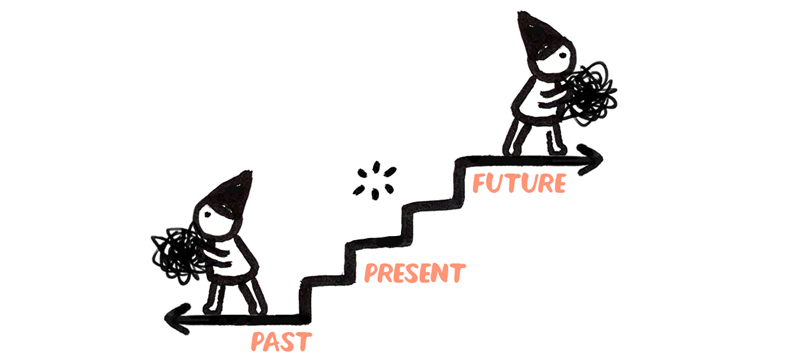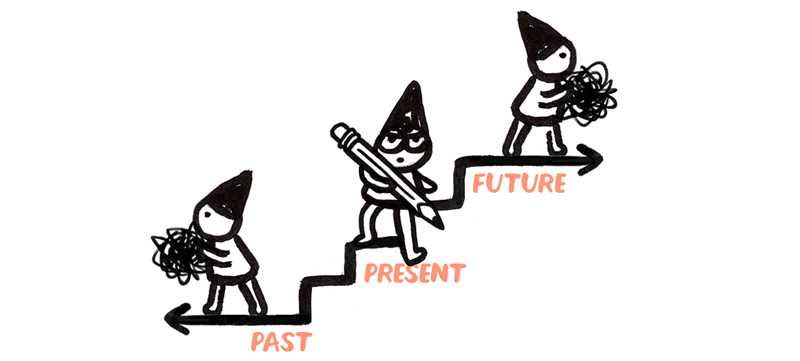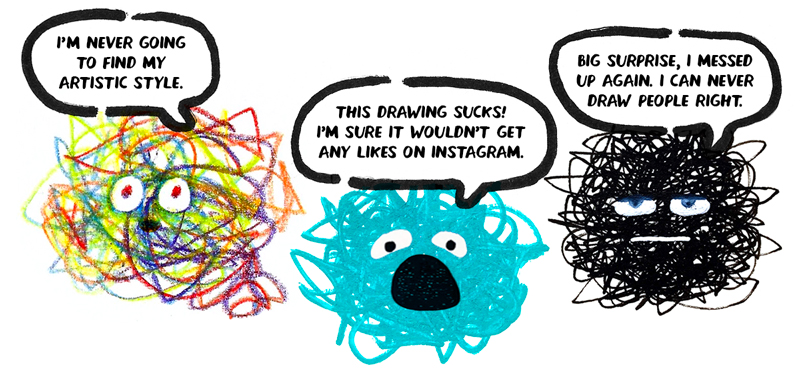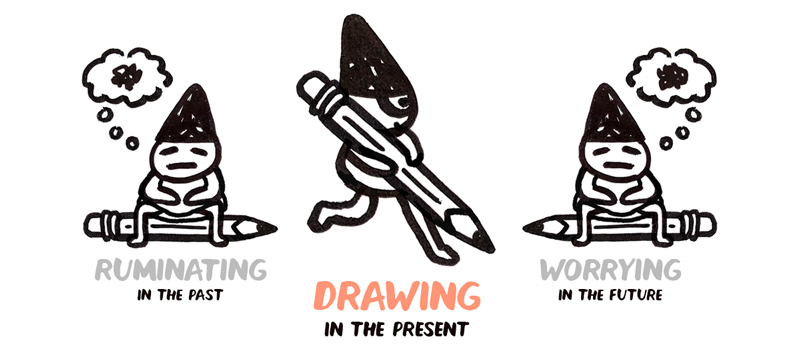
📝 NOTE: This is an ongoing series on my theory of Artistic Intelligence (AQ). New here? You can read the first essay in the series here.
The Mental Shifts of AQ
There are 7 mental shifts that must happen for us to move from a Toxic to Nourishing mindset. This week I’m covering the third mental shift. You can find the previous shifts linked below.
- Shift 1: Unaware while making art → Intentional while making art
- Shift 2: Thinking while making art→ Experiencing while making art
- Shift 3: Creating in the past or future → Creating in the present
The Scenario
Imagine the following scenario:
You’re drawing something in your sketchbook and your mind starts to wander. Where does it go? Is it in the present, paying attention to the marks you’re making on the page? Or is it in the future, worrying about what other people will think of the drawing when it’s done? Or is it in the past, ruminating on how you keep messing up everything you try to draw?

Thinking in the Past and Future
The fact that our minds can think about the past and anticipate the future is amazing and of course helpful for life as a human. But that same mental time-traveling skill becomes problematic when it takes over our thoughts.
When that happens, we get sucked into the past and flung into the future, skipping over the most important thing: what we’re drawing right now. We can’t make art in the past or the future. We can only make it now, with what we have in this present moment.
It’s natural and normal for our minds to want to relive the past and anticipate the future. We can’t totally stop that from happening. But we can become aware of when we’re mentally time traveling and choose to bring ourselves back to what’s right in front of us. Not the mistakes we’ve made in the past. Not the mistakes we might make in the future. But the present moment. The art we’re drawing right now.

Bringing Yourself Back to the Present
We can do this by going through 4 simple steps:
- Noticing when our thoughts wander into the past/future
- Listening to where our thoughts are really at right now
- Letting go of the thoughts we don’t want to hold on to
- Gently bringing our attention back to drawing
This process—recognizing when our thoughts have drifted out of the present moment, and bringing our attention back to the present drawing—is one of the most important skills of Artistic Intelligence.
The following exercise is designed to help you notice and listen to your inner world and practice letting it go, bringing yourself back to the present while drawing.

Exercise 1: Mind Squiggles
For this exercise you’ll need: Your sketchbook (or paper), and a pen or pencil.
You can choose to do this exercise anytime, but it’s designed to be done when you were already in the process of drawing something else.
- When you notice your mind starts to wander away from what you’re currently drawing, close your eyes and pause.
- Ask yourself, “What am I experiencing in this moment? What thoughts? What feelings? What physical sensations?
- Now open your eyes and turn you attention back to your sketchbook.
- Draw a squiggle on the page, noting any sensations of discomfort. Imagine any worries or anxieties in your mind flowing from your mind, down your body, and through your pen, seeping into the page through this squiggle. Make the squiggle for as long as you keep having thoughts based in the past or future.
- Once you notice you’re paying attention to the act of drawing your squiggle, rather than thinking thoughts, stop drawing the squiggle.
- Now look at your squiggle. Imagine your squiggle is a creature made up of all those thoughts you were thinking. Draw a pair of eyes and perhaps arms and legs on this new squiggle-creature. What type of mood is it in? Is it doing anything? Is it saying something?
- Now that you’ve noticed your thoughts, listened to them, and released them on to the page, you can gently bring your attention back to what you were originally drawing with your mind anchored in the present moment.
- Repeat as necessary.

Why We Did It
Learning to redirect our attention while drawing is a huge part of pulling ourselves out of the past or future and into the present moment of drawing. Instead of unknowingly getting swept up in our thoughts and feelings—buying into them, believing them, and getting stuck in the muck—this exercise encourages us to shine a direct light on those worries.
Then, drawing those worries as squiggle creatures brings the thoughts out from our inner world to the outer world, putting a separation between the thoughts and us. This makes it easier to see them for what they truly are—thoughts, not facts—that we can choose to let go.
When we’re stuck thinking about the past or future, those thoughts, feelings, and worries can become overpowering. They can spiral out of control leading us to believe terrible things about our art and ourselves. The thoughts seem so serious and real! Drawing them as funny little squiggles helps bring lightness back to experience and take away some of the thought’s power over us.
Going through this exercise helps us adopt a more gentle, peaceful mindset where we can more easily access our creativity and pull out the art inside us!

Up Next!
Going through this process of listening to our thoughts while drawing means directly confronting difficult things—our mistakes in the past, our worries about the future. As much as you may think about those things, we actually spend most of our time avoiding dealing with them.
If I keep thinking, over and over, about how “I can’t draw hands” every time I try to draw a hand, I’m going to start believing that I can’t draw hands. And that belief will inevitably lead me to avoid drawing hands.
If we want to improve and develop our art, we have to face those difficult thoughts, listen to them, and then let them go, so we can get back to the task at hand—drawing this drawing, right now.
I’ll be back next week to dig deeper into how!
❓Do you get caught up in the past and future while drawing?
I’d love to hear what you think of these concepts and exercises! Head over to Might Could Studiomates to join the group discussion (did you know we have a free plan now?) or comment below to share your thoughts!

